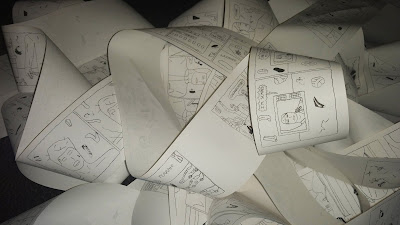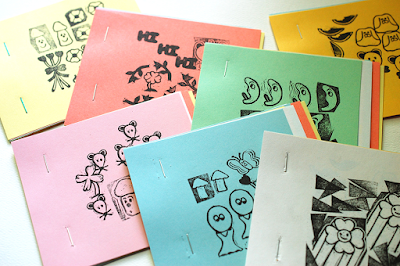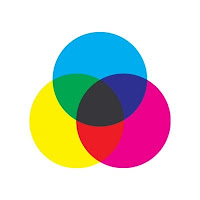Since 2016, CF has made two sets of receipt comics. Each set has three comics made of a sheet of receipt paper around 40 feet. The materiality of the comics shows us CF’s persistent interest in the ephemerality of comics medium.
Receipt paper is cheap, disposable, and ephemeral. It is weak in heat and sunlight; it changes color and loses the ink. It is not intended to be archived for a long time. It is not to be re-read several times. Once you read it, it is hard to re-roll it and the re-rolled “zine” differs greatly from the original state.
As we communicate more on screens and less with the physical paper — books, newspapers, and magazines — receipt paper is the most used kind of paper right now. We could argue that CF’s receipt zines criticize the fall of civilized discourse, which could be symbolized by the physical paper media of books, newspapers, and magazines, as well as the rise of the “fake news” by highlighting the remnant of the physical paper that only matters when money is involved and is fleeting, just as social media is.
Beginning in the late 90s, as part of Paper Radio (with Ben Jones), CF utilized the low cost of newspaper paper to distribute comics freely. Paper Rodeo, the newspaper anthology CF, Fort Thunder, and Paper Rad (which Ben Jones was part of) participated, was also freely distributed. The newspaper paper shares impermanence and cheapness (both in the price and quality) of receipt paper. They produced these zines secretly at photocopiers not paying for printing. Their confusing names (Paper Radio/Rad /Rodeo) and the fact that Paper Rodeo does not have credits adds to the difficulty of archiving these zines.
Not only the distribution and material practice but also CF’s style tells us the artist’s interest in the ephemeral nature of comics. Arguably one of the most influential but under-discussed practices of CF was utilizing a pencil as the main tool. Coinciding with the fast-drawn style that focuses on the fleeting moments and art rather than the structure of the whole narrative, pencil-drawn Powr Mastrs was one of the most influential comics of the last decade in art/alternative comics.
That one of CF’s receipt zines was originally published in Volcan anthology as two-dimensional pages but then re-edited as one-dimensional rolling receipt paper, as well as the fact that the CF receipt zine set contains other artists’ zines like Carlos Gonzales, show that CF’s attention was in the material practice, rather than the contents of the zines.
Finally, the receipt zine progresses in a one-dimension contrast to the two-dimensional traditional paper medium including print comics, newspapers, books, and magazines. While perpendicular, it reminds us of the smartphone vertical infinite scrolling interface we use every day. We could connect this aspect with the death of established print media discussed above.
*****
Ginette Lapalme on Reproduction
Female-centric cultural practices such as embroidery have been relegated as mere “craft” of ethnographic records as opposed to high art like paintings or sculptures [1]. Another point of contention is originality versus reproduction (copying): craft is something deferential, but the concept of originality comes from a “genius man”. The gendered (sexist) divide also occurs when women are the majority of audience of a cultural product: thrillers or war movies are critically appraised and included in the canon, but “chick flicks” or romantic comedy are not; sex and violence are edgy, but “girly” and “feminine” cuteness is not.
Ginette Lapalme mediates such division of gendered high and low art with cute artworks interrogating the concept of reproduction and originality
Lapalme’s works come from the process of reproduction. It means two things: first, in a reproduced medium such as zines, comics, and apparel, Lapalme produces each distinct “copy”. One of the most fascinating examples of this is Climb-ing Mushroom Fabric Zine (2018), a silkscreen zine of dyed and bleached fabric (canvas) instead of sheets of paper. Every zine has the same drawings/silkscreens of characters, but each copy “is unique in its coloring and also slightly different in its composition page to page” by varying the size, color, or position of tie-dyed fabric flap or color and size of fabric sheets.
Second, Lapalme’s cute artworks are often made from vernacular ugly/cute mass-produced objects. For example, Lapalme adds her paintings or sculptures to Made-in-China stationeries. In A Little Sampling (2019), Lapalme juxtaposes her drawings and sketchbook pages with vernacular clipboard images, re-drawn clipboard images, and computer-edited images of both. In a way, all artistic motives are clip-art, appropriated again and again. Lapalme’s incredibly cute beings could be clip art too. They populate Lapalme’s artistic world: sketchbooks, zines, paintings, sculptures, apparel, comics, drawings, pins, earrings, etc.
Lapalme produced My Stamps Collection (2019) while carving dozens of stamps into the likeness of her aforementioned cute creatures. She reproduces images from her hand-made stamps to create this zine. Lapalme also produced a poster with these stamps. Compared to A Little Sampling, Lapalme materialized an analog “clip art” database of her artworks as stamps. But there is a twist about My Stamps Collection: many of the images are similar, but are in actuality a little bit different from each other, reminding the viewer of comics’ principal dialectic relationship of repetition and difference. Because Lapalme created zines as she was sculpting stamps, she was able to record the trace of transient stamps. We cannot reproduce these images anymore because the source (the transient stamp) is carved away to reproduce slightly different images. The ontology of the image does not exist anymore.
Ginette Lapalme intervenes related dichotomies of high and low art and originality and reproduction. In the digital age where reproduction is extremely easy and universal — copy and paste are implemented as a basic function of a computer — by focusing on physicalities of "crafty" objects such as fabrics and stamps, Lapalme shows the potential of images that have not been appreciated.
[1] Lucy Lippard. From the Center: Feminist Essays on Women’s Art. 1976
------------------------------------------------------------------------
Kim Jooha lives in Toronto, Canada. She was Associate Publisher at 2dcloud. You can find her writings at kimjooha.com and
@realasianfriend on Instagram.












No comments:
Post a Comment